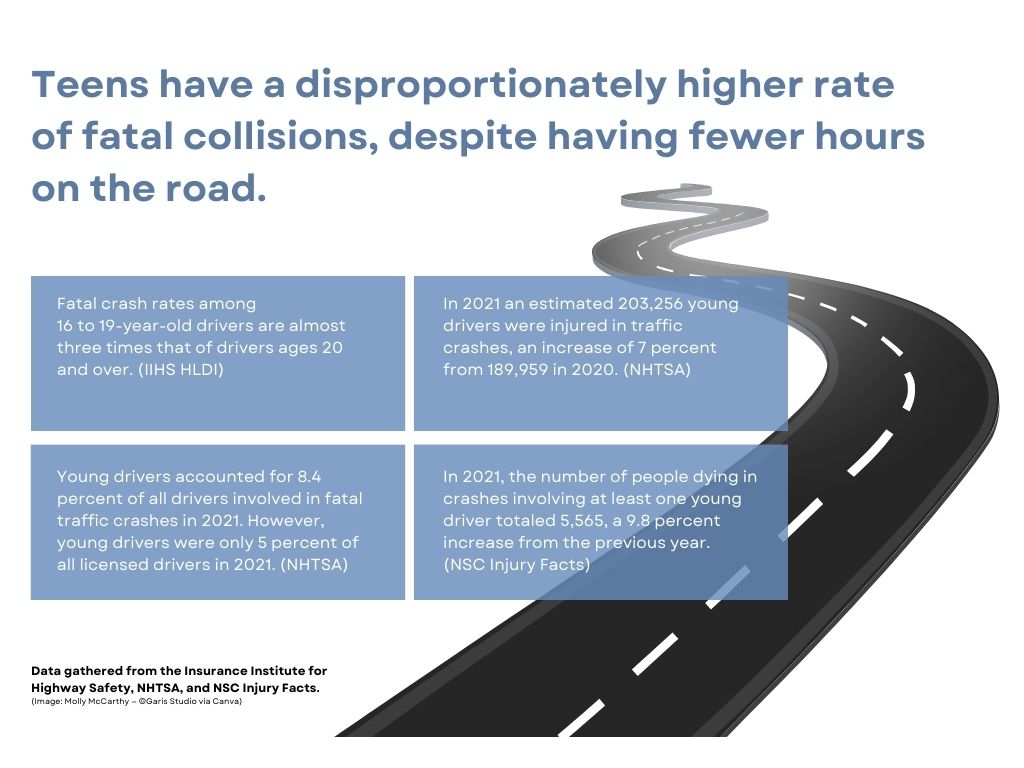A wise parent once said, “Imagination is something that sits up with dad and mom when their teenager stays out late.” But what if parents could quell their imaginations with a few reliable driving apps and features to keep teenagers safer when they venture out on the road?
Teen Driving Safety: Facts & Trends
Over the past 30 years, the number of young drivers in the U.S. has generally decreased. According to University of Michigan researchers, the percentages of persons 19 years of age with a driver’s license in 1983, 2008, and 2010 were 87.3, 75.5, and 69.5, respectively. Recent Federal Highway Administration data shows a continued decline. Just 68.3 percent of 19-year-olds in the U.S. obtained a driver’s license in 2021.
The Insurance Institute for Highway Safety estimates that teens have a disproportionately higher rate of fatal collisions, despite having fewer hours on the road than almost every category of driver except the elderly. When measuring by the mile driven, fatal crash rates among 16 to 19-year-old drivers are almost three times that of drivers ages 20 and over. The highest likelihood of a fatality is between the ages of 16 and 17. According to data from The Governors Highway Safety Association and the Ford Motor Company Fund, speeding is the leading cause of death for teenage drivers.

Teen Driving Safety Apps & Features
Without proper instruction, teens lack the knowledge base that allows them to effectively scan the road to anticipate the actions of other drivers. This inexperience, nighttime and weekend driving, lack of seatbelt protection, and distracted driving are the factors that cause most teen driver crashes. Auto manufacturers are moving quickly to enable and improve safety innovations to protect young drivers against several of these threats.
Depending on the car company, teen protection technology may contain lane departure warning systems, automatic emergency braking, and blind spot monitoring. Other safety systems include seat belt chimes that sound and mute the audio equipment until the passengers in the front seat buckle their safety belts. Select models allow parents to cap a vehicle’s velocity at predetermined speeds. Other car models can include parking assistance, tracking systems that limit tire spin, and an earlier-than-usual “empty tank” warning at 75 miles remaining.
Teen-specific driver technology was first brought to market in 2009, with Ford and Lincoln’s MyKey. Since then, other manufacturers have followed suit and continue to update their offerings with the latest technology. Here’s a snapshot.
- First introduced in 2009, Ford and its luxury brand, Lincoln, feature various models with MyKey technology. MyKey assigns a key fob to a young driver to limit the vehicle’s top speed, prevent the driver from turning off certain safety features, and limit sound system volume.
- In 2012, Hyundai and Kia introduced the Blue Link system, which relies on geo-fencing technology to map boundaries around certain geographic areas. When the vehicle enters or exits the predefined boundaries, parents or guardians are notified.
- Introduced with the 2016 Chevy Malibu, GM, together with its Cadillac, GMC, and Buick brands offers models equipped with Teen Driver technology. Beyond the standard safety features, some GM models offer a “report card” outlining driving behavior, including distance driven, maximum speed, and number of times certain safety systems were activated.
- In 2017, Toyota and Lexus announced Entune 3.0, which evolved into a mobile app. The app allows owners to remotely lock or unlock car doors, start and stop the engine, and monitor fuel. It also records the time, speed, and area the car is driven.
- In 2023, Honda and its higher-end brand, Acura, launched the Honda Driver Coaching App for iPhones. The app, intended to improve the skills of new drivers, connects via Apple CarPlay and analyzes driver inputs – including steering, braking, and acceleration – in real time, instructing the driver when they need assistance. When the lesson is complete, the app produces a summary of their drive, tips for improvement, and a final score, which allows users to track their progress.
Beyond The Technology
There are many steps parents can take to increase the safety of their teen drivers, and some of the most effective steps do not rely on the latest technology:
- Talk with teens about the dangers of driving while tired or under the influence of drugs and alcohol. Explain exactly how these factors can gravely impair reaction time and judgment. Be mindful of prescription drugs as well. Even though a trusted family physician may have prescribed them, all drugs can have potential side effects that can impair your teenager’s ability to drive.
- According to NHTSA, sending or reading a text takes roughly five seconds. At 55 mph, your teenager’s vehicle will cover an entire football field by the time they look up again. Define clear boundaries about phone usage and driving. Set consequences for infractions and limit driving privileges if infractions occur.
- Model safe driving skills because teens adopt their parents’ driving habits. Teens begin learning to drive as passengers in the car, observing their parents. Driver’s education classes are just one piece of their safety training. Watching their parents navigate traffic is an equally important lesson.
- Adhere to Graduated Driver License Laws. In 2020, 44 precent of motor vehicle crash deaths among teens ages 13 to 19 occurred between 9 p.m. and 6 a.m., and 50 percent occurred on Friday, Saturday, or Sunday. The Graduated Driver License Laws throughout the country are designed to combat these horrific incidents. Though they vary from state to state, these laws establish several restrictions for teen drivers, including limited night driving and required hours of supervised driving.
- Have your teenager’s car inspected by a trusted mechanic who will look more closely at safety-critical components like the tires and brakes. Having your teenager’s car in good running condition will help ensure their safety.
Instill Good Driving Habits
As parents ready their teens for the road, there are new technologies that can not only help young drivers stay safe but also give parents a bit more peace of mind. Still, old-school methods, including modeling good driving habits, spending quality time teaching teens the rules of the road, and maintaining a dialogue with them as they begin to navigate the road independently, can go a long way toward instilling good driving habits.
*Melissa Malley, a writer in Los Altos, California, contributed to the research and writing of this article.


